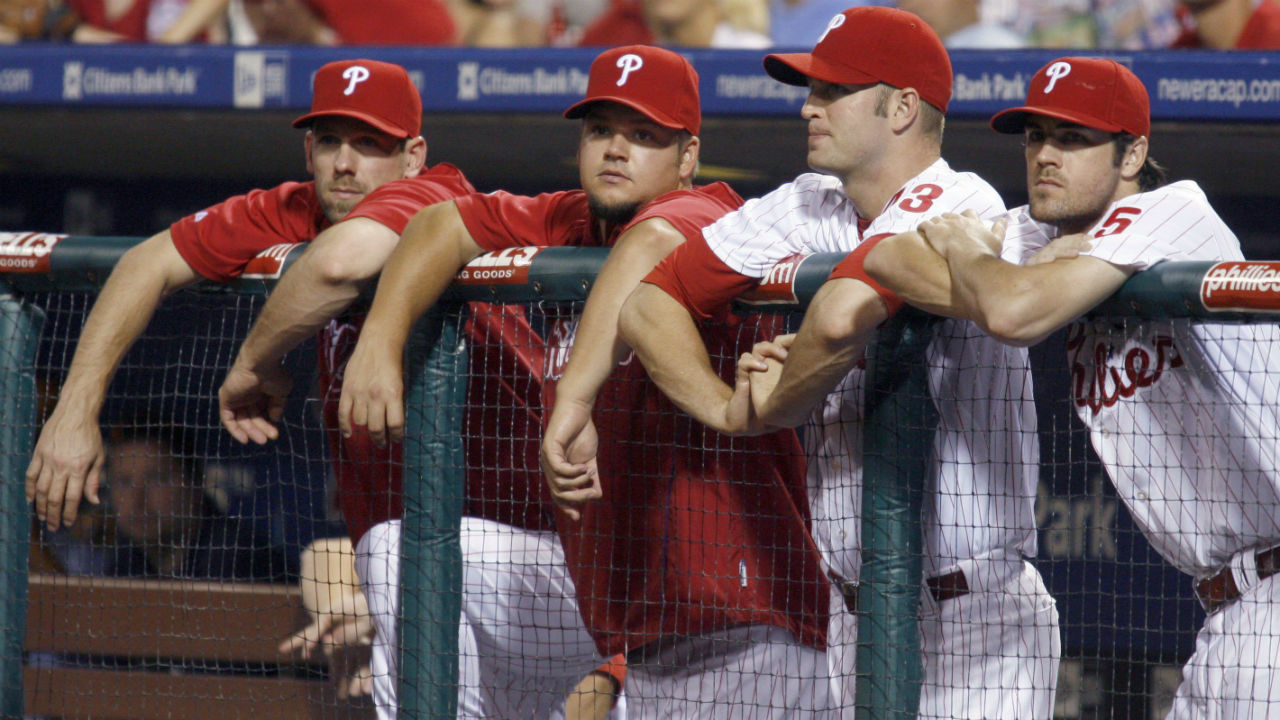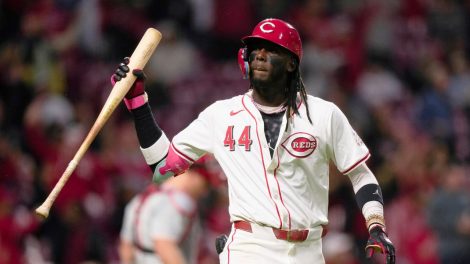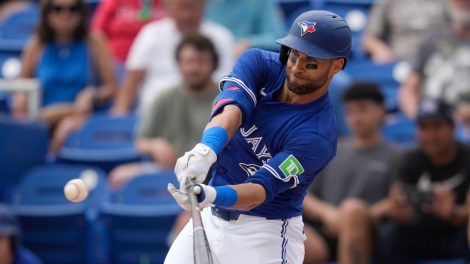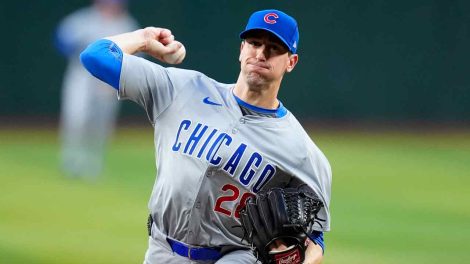Uncertainty was a staple of J.A. Happ’s first tenure with the Toronto Blue Jays. Upon his acquisition from the Houston Astros on July 20, 2012 as part of a 10-player deal, the left-hander was promptly moved to the bullpen in order to keep Aaron Laffey in the rotation.
The following spring, talk of optioning him to triple-A Buffalo hovered around throughout camp until he ultimately agreed on an $8.9-million, two-year extension that was unenthusiastically announced by the club. Two years later, just as it seemed that he had turned a corner, he was flipped to the Seattle Mariners for Michael Saunders.
That’s why he wasn’t sure what to make of the Blue Jays’ interest in him when he became a free agent following the 2015 season. The first go had pretty much been turbulent wire-to-wire, and rarely did he feel sure of how the organization felt about him. Yet Happ was impressed by the way Tony LaCava, the interim general manager at the time, came after him and the veteran executive was pivotal in convincing him to sign a $36-million, three-year deal that has worked out well for both player and club.
“Tony’s just one of the highest quality guys in the game that I’ve met. That helped in the process. I felt like I was wanted here and that meant a lot to me. Tony was a big reason why I came back,” says Happ. “I remember telling my wife, ‘I’m going to turn my reputation around here.’ I just felt a little different as a baseball player. I had just become a father and had a little more perspective. I was never really good at separating personal life and the business of baseball. Having a family helped me with that.”
[snippet id=3918627]
Over the past two years with the Blue Jays, the 35-year-old has finally reached the potential he first flashed with the Philadelphia Phillies in 2009, when he posted a 2.93 ERA in 166 innings over 35 games, 23 of them starts. Thursday’s Opening Day start against the visiting New York Yankees (Sportsnet, 1:00 p.m. ET), the first of his career, is a fitting bit of recognition for someone who’s endured a long grind and earned the privilege.
“Call it whatever you want, but it just feels good to have an organization, a manager, coaches that have confidence and faith in you, you know what I mean?” says Happ. “We say it all the time, any of these guys could do it, they probably feel the same way, they’re all going to do it, or have done it at some point in their careers, but I certainly take it as an honour, no doubt about it.
“It’s going to be exciting for me.”
The Phillies made Happ a third-round pick out of Northwestern University in the 2004 draft and he debuted three years later against the New York Mets, allowing five runs in four innings of work. At the time the six-foot-five, 205-pound native of Peru, Illinois was largely a fastball-changeup pitcher with a cutter mixed in, his windup featuring a backwards arc as he delivered the ball.
It worked brilliantly in 2009, when he came out of the bullpen in May and was strong in the rotation, a five-hit shutout at Toronto on June 27 among his gems for the defending World Series champions.
“People call the big-leagues ‘The Show’ – that was ‘The Show’ there because, that’s sold out every night, you’re winning, unbelievable offence, unbelievable all-stars and Hall of Famers on your team,” says Happ. “But it was very much like an old-school like organization.
“I came up and there’s a lot of that respect, kind of not speak out and whatever. I didn’t mind that. I thought that’s kind of how it was. Ten years later, you’re looking and the game has changed a lot in every sense. You were always kind of put in your place to that extent, but it certainly was fun.”
Later that summer, the realities of life in the big-leagues first struck Happ. The Blue Jays were shopping Roy Halladay, who wanted no part of their looming rebuild, and the Phillies were all in.
As a 26-year-old performing at the big-league level with five more years of control, Happ was precisely the type of asset the Blue Jays wanted in return. They also liked some of the Phillies’ prospects, Kyle Drabek and Dominic Brown first among them, but the teams couldn’t find common ground. Eventually, the Phillies shifted gears and acquired Cliff Lee from Cleveland for four prospects, including Carlos Carrasco, who ended up being the right guy to target.
“I heard the rumours, for sure,” says Happ. “I was a little uneasy. I have a different perspective looking back, I’ve been traded a few times now, but most players are like, ‘I don’t want to go anywhere, this is all I’ve ever known.’ You’re a little uneasy about that potential, but you couldn’t blame them for trying to get Roy Halladay.
“I wanted to be there because the team was successful, and I wanted to be a part of that.”

Happ made seven post-season appearances as the Phillies lost the World Series in six games to the Yankees. In the off-season that followed, Halladay ended up in Philadelphia as part of a three-way swap that landed Lee in Seattle and sent Drabek, catcher Travis d’Arnaud and outfielder Michael Taylor to the Blue Jays.
A year later, Happ didn’t survive the trade deadline.
As if a rotation fronted by Halladay and Cole Hamels wasn’t good enough, the availability of Roy Oswalt at the trade deadline proved to be far too alluring for the Phillies to pass up. A strained left forearm had sidelined Happ for all but three starts to that point, and with Joe Blanton, Kyle Kendrick and Jamie Moyer also around, he became expendable.
The rumours had started the night before the July 29 deal was consummated, but without any official word he came to the field the next day and was sitting in a lunchroom when he saw running across the ticker that he and prospects Anthony Gose and Jonathan Villar were headed to Houston for Oswalt.
“It was an awkward situation,” says Happ. “Nobody told me anything so I was like, ‘All right, I’m just going to keep doing what I’m doing.’ So I went out to run outside on the field and then they called me in and told me.
“I can’t lie, I was emotional. I really felt a connection there, liked being there, so that was tough. But that prepared me for the business end of the game, let me know that that’s a very real possibility.”
The Astros were about to embark on the rebuild that culminated in last year’s World Series championship, but when Happ first arrived they still had established players like Carlos Lee, Hunter Pence, Michael Bourn and Wandy Rodriguez. They finished fourth in the NL Central that year but went full tank in 2011, going a dismal 56-106.
“That was a really tough year for the organization as a whole, myself included,” says Happ. “It was hard going from almost winning 100 to losing 100, it’s a big difference in an atmosphere and culture, a winning baseball culture. That was a pretty drastic change.”
By then, Happ had started to evolve on the mound. The bend in his back from his Phillies days was gone, moving more toward a tall, upright stance throughout his motion. The movement in his stride following his leg kick had changed, too, eliminating a gate-like swing toward the third-base side of the dugout in favour of a direct step toward the plate.
“What I want is my head to be still,” he explains. “It’s really hard to consistently throw strikes when you’re moving your head a lot. One of the things I really focused on is to keep my chin direct on a line and have my leg go directly to home plate on a line. I’ve got to release going toward home plate.”
But mechanics weren’t the issue in 2011, when he went 6-15 with a 5.35 ERA in 28 starts. He jokes now about wanting to suppress the memories of his time with the Astros.
“It was just difficult mentally,” says Happ. “I got in my own way a little bit. I got caught up in the losing and the lack of success and all that stuff intertwined, feeling helpless a little bit. That’s why I say try to suppress those memories. I don’t want to say forget because, looking back, I learned a lot from those experiences. But I don’t want to go through it again.”
In 2012, Happ was pitching better when he was traded for the second time, and, somewhat ironically, to the team rumoured to be pursuing him before the first deal. The Blue Jays were desperate for pitching that summer after losing Drabek, Drew Hutchison and Brandon Morrow for extended periods over a span of four games.
The trade was, “a shock. I didn’t expect it,” says Happ. Yet even more shocking was that with Laffey and Brett Cecil serving as stopgaps in a threadbare rotation, the Blue Jays initially dispatched him to the bullpen.
The entire situation left him disoriented.
“When I got here, and I was trying to figure out and have conversations and have meetings for the next year and a half. ‘Where do you see me? Why am I here? What’s the plan?’” says Happ, who couldn’t understand why an established starter like himself was being used as a reliever. “That’s what was confusing to me. I don’t know what happened there. I’m sure it all relates to the success you have, or don’t have, and how people view you, but I felt like I was viewed a little unfairly the first time around, maybe.
“Especially in that moment when I felt like, yeah, I should probably be a starter over here, I thought you brought me over to be a starter, that’s what I’ve done most of my career. So I was just trying to find my footing and it was a constant trying to prove yourself type of thing, which is OK, because that’s part of baseball.”
Between the 2012 and 2013 season, the Blue Jays loaded up, acquiring Josh Johnson and Mark Buehrle as part of a blockbuster with the Marlins before adding R.A. Dickey in a separate deal with the Mets. With Happ, Morrow and Ricky Romero already in house, the Blue Jays seemed to have more starters than they needed, which led to the talk that Happ could be optioned.
But as spring ended, an extension was struck just as Romero was demoted to single-A Dunedin in the hopes a tune-up would allow him to revive his career. A hastily arranged news conference to announce Happ’s signing added to the bizarre nature of the entire episode.
“You know, I think the old leverage game came into play. Both sides tried to use what they could,” says Happ. “It was like, ‘OK, we’re going to go,’ but there still wasn’t a huge commitment [from the team], like this is a guy that we think can do whatever. It was like, ‘We did that.’”
The 2013 campaign was a tire fire for the Blue Jays and in a frightening incident, Happ suffered a knee injury while collapsing after being struck in the head by a line drive. By the time he returned, the season was already lost.
The following spring he began experimenting with a lower arm slot but ended up abandoning the whole venture “because I wasn’t getting the kind of swings I wanted. I felt good doing it, I felt like I could throw strikes, but I wanted to see more results from this angle than I was seeing.”
Instead, Happ moved his arm slot down just a touch, enough to ease the command issues that so often plagued him as he came over the top. Not only did he end up with better command, he began developing a two-seamer that has now turned into an important weapon for him.
Similarly, he began learning to have more faith in himself.
“The whole believing and getting more consistent happened in that second half of ’14,” says Happ. “I had good numbers in the second half, I had the option, they picked that up, and then they traded me.”
Trade No. 3 sent Happ from the Blue Jays to Seattle, where things went sideways for both him and the team after a decent start. Trade No. 4 soon followed, a deadline dump to the Pittsburgh Pirates for right-hander Adrian Sampson. The Blue Jays had actually inquired about Happ before that deal but couldn’t make the money work after earlier pick-ups of David Price, Troy Tulowitzki, LaTroy Hawkins, Ben Revere and Mark Lowe ate up their budget.
With the Pirates things finally came together for Happ, as he posted a 1.85 ERA over 63.1 innings over 11 starts. By the time he hit the open market, the Blue Jays were convinced the results in Pittsburgh were real.
“I just gave it up to, something’s got to change here, I’ve got to get back to being that guy that I know I can be, I know I should be,” says Happ. “I started to roll off a few and have some success, and just really had a confidence I hadn’t had in a while. It was a tough situation in Seattle, too, we were losing a lot of games when we weren’t supposed to and we had to do a lot just to be in a game.”
[relatedlinks]
The Blue Jays and Happ reunited on Nov. 27, 2015 and the following season he rewarded them by winning 20 games during the regular season and one more in the post-season.
The milestone victory came against the Mariners in Seattle and afterwards, Jamie Moyer, his old teammate and close friend on the Phillies sent him a congratulatory bottle of champagne.
The entire campaign was a cross between vindication and validation.
“I always just kind of kept my head down and kept grinding and kept working, and then it was fun to look back and have that kind of season and to look at some of the things that happened along the way after I did,” says Happ. “I always tried to just forget about the last one and focus on the next one, just trying to be in that kind of mode the whole season. That’s how I always am but it certainly meant a lot, and then I think it went a long way into helping appreciate maybe how I’m viewed a little bit.”
Last year an elbow injury limited him to 145.1 innings and 25 starts, but he was a pillar of stability every time he took the mound.
This year, he’s the opening-day starter, a fitting honour for one of the most respected players in the Blue Jays clubhouse, who for years chased excellence, and eventually found it.









